Shopify vs Wix is a clash of two of the biggest names in the world of ecommerce, with the stats for these platforms being truly mindblowing:
- Shopify has over 4 million users and a 25% market share of all ecommerce platforms (number 1 overall)
- Wix Stores has over 2 million users and a 13% market share of all ecommerce platforms (number 3 overall)
Which is very impressive but which one is the best ecommerce platform?
Well, that is what we are going to answer in our in-depth comparison, which covers all of the important aspects you need to consider when choosing an ecommerce platform.
All stats were sourced from Builtwith.
EcommerceGold is reader supported and we may earn a commission from products or services purchased through links on our site at no additional cost to you, to learn more please see our affiliate disclosure.
Shopify vs Wix: Quick Summary
If you don’t want to read through our full comparison, we have done a quick summary for you.
Both Shopify and Wix offer a very good platform for ecommerce businesses but Shopify came out on top for the following reasons:
- Shopify’s performance was a lot better than Wix
- Shopify’s dashboard and website builder are easier to use
- Shopify offers a much larger selection of apps
That is not to say Wix is bad as the pricing is very attractive and it does offer some features (such as digital downloads) as standard that Shopify doesn’t but we feel that Shopify offers the better overall package when it comes to building an ecommerce website.

EcommerceGold Score


EcommerceGold Score
Pricing


As you can quite clearly see in the table above, Wix’s subscription fees are considerably cheaper than Shopify’s but the monthly cost isn’t the only factor that you need to consider.
Shopify
Shopify also charges a transaction fee on all payments received using third-party payment gateways, such as PayPal and Amazon Pay and it does depend on the plan you are on as to the fee you pay:
- Shopify Basic: 2%
- Shopify Standard: 1%
- Shopify Advanced: 0.5%
These fees don’t apply when using Shopify’s in-house payment gateway, Shopify Payments but this does make finding out which plan to go on a little more challenging but you can use tools like our free Shopify fee calculator to help you figure this out.
Wix
Wix is a little bit sneaky when it comes to displaying their prices as the ones shown on their site and in the table above are if you pay annually for your plan, if you want to pay monthly, then you will pay a higher price.
But they also offer larger discounts for plans that are bought for 2 or 3 years upfront.
When it comes to additional charges, Wix doesn’t have any as they don’t have:
- Additional transaction fees
- Annual turnover limits
- Limits on the number of products you can sell
This means that Wix does work out a lot cheaper than Shopify.
Free Trial
Shopify offers a 3-Day Free trial, which only requires an email address and to create a password, the first paid month will only $1.
Wix operates a bit differently as you sign up to a free account, which allows you to install and test the Wix Stores app but you can’t take orders through it. They do offer a 14 money-back guarantee on their ecommerce plans.
Features
As two of the biggest website builders in the world, you would expect them to both come with a good range of features, but what do you get exactly?
Shopify
As Shopify was designed primarily as an ecommerce platform, it is not surprising that the majority of its features are aimed at ecommerce. Even with the basic package, you get a large range of features built into the platform as standard and as you move on to the larger packages, you do get more features.
Ecommerce Tools
- Dropshipping Integration
- Flexible Shipping Rates
- Multi-Language
- Product Reviews
- Digital Products
- Gift Vouchers
- Shopify Management App
Marketing & SEO
- Google Adwords Credit
- Sell on Facebook
- Discount Codes
- Abandoned Cart Recovery
- Auto-Generated Sitemap
- Social Share
- Blog
- Custom Meta Data
- SEO Friendly URLs
Reporting
- Product Reports
- Traffic Sources
- Google Analytics
- Day, Week and Monthly Reports
Payment Gateways
- Shopify Payments
- PayPal Express Checkout
- Amazon Pay
- Klarna
- Worldpay
- Sagepay
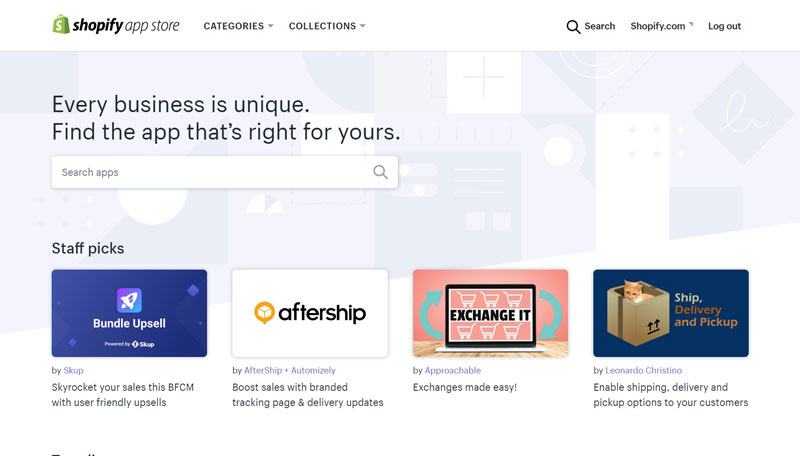
Shopify App Store
If the standard features of the Shopify platform aren’t enough for you, then you do have access to the Shopify App Store, which has over 3,000 apps that have been made by the Shopify team or third-party developers that add a variety of different functionality to your store.
Unfortunately, not all of these apps are free to use, many come with a free trial or plan but to get access to all the features, you will need to use a paid plan and if you are not careful, this can make Shopify quite expensive.
Wix
As Wix was originally a website builder and the ability to sell on the platform comes in the form of the Wix Stores app, this adds a checkout and product pages to your Wix website. Combined, Wix and the Wix Stores app offer the following features:
Ecommerce Tools
- Sell Physical & Digital Products
- Discount Coupons
- Create Promo Video
- Live Chat
Marketing & SEO
- SEO Friendly URLs
- Custom Meta Data
- Send via Email Campaign
- Share Product to Social Media
- Sell via Facebook and Instagram
- Blog
Reporting
- Orders
- Conversion Rate
- Revenue
- Purchase Funnel
- Top Email Campaign
Payment Gateways
- PayPal
- Wix Payments
- Stripe
- Square
- SumUp
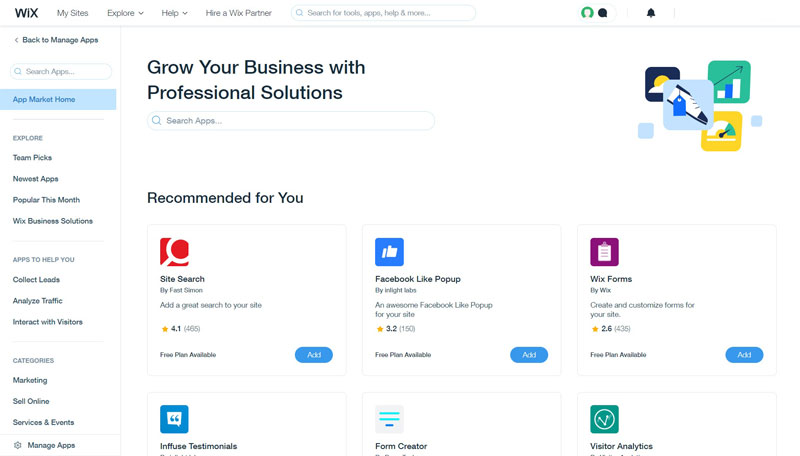
With all Wix packages, you also get access to the Wix App Market, which has a variety of apps that are made not only by the Wix team but also by third-party developers. While not as big of a selection as you get with Shopify, there is still a good range to choose from.
While the majority of these apps will have some form of free plan, to get all of the features of the third-party developed apps, you will have to upgrade to a paid plan on top of your existing Wix package.
One of the things that really does let the Wix platform down is the poor selection of payment gateways on offer and there are no additional ones available in the App Market.
Theme Selection & Customization
Shopify
In November 2021, Shopify implemented its OS 2.0 system for themes and theme customization, which is designed to give users more control over the look and feel of their site.
With this update, came a selection of new themes including 9 free options and over 80 paid, which range from $200 – $350.
The big change came to the customizer and while it was no slouch before, it was basically limited to the homepage but the new system has been expanded to pretty much all types of pages that you can create through Shopify.
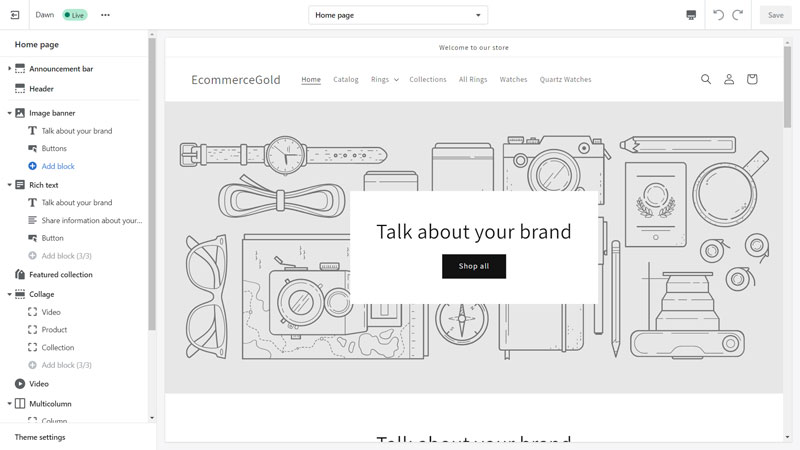
When it comes to customization, there are lots that you can do, including:
- Adding, removing and re-organizing sections
- Make changes to the header and footer
- Customize the font styles, sizes and colors
- Change colors across the theme including buttons
- Create custom templates for pages
- Live preview, so you can see changes before sending them to your live site
Overall, the new customizer is a very good improvement over the old one and is one of the best customizers on the market.
Wix
Wix offers a much larger selection of themes, with over 100 available for online stores but it isn’t easy to switch between themes as you need to create a new site and then transfer your subscription over to that site and not all things will transfer over, so not an ideal solution.
When it comes to customization, Wix offers a full-site editor and this offers a lot of control over your site as you can:
- Add, remove and rearrange sections
- Drag and drop elements
- Customize different page types
- Change colors and fonts
This gives users a lot of control over the look and feel of their site but it could be argued that it gives too much control as you can make minor adjustments, such as dragging an element slightly to the right that makes no difference to user experience but you can waste a lot of time doing.
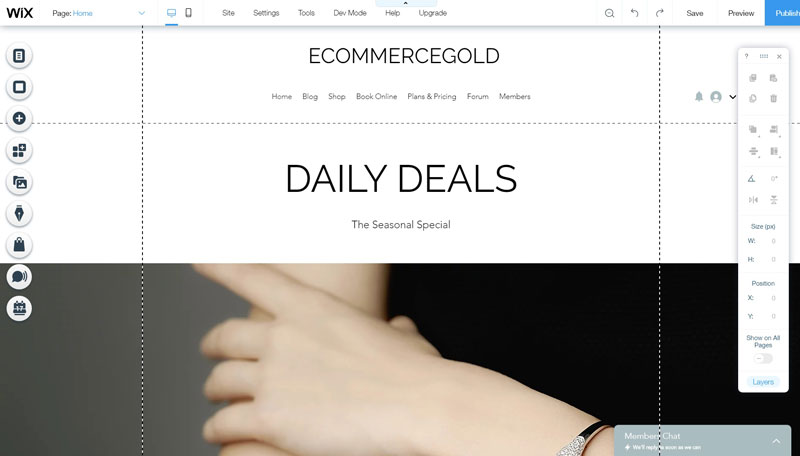
Support
One of the reasons why people choose a hosted platform such as Shopify or Wix is that they get help and support to run their website. But how good are Shopify and Wix when it comes to support?
Shopify
Shopify made some changes to their customer support in 2023, with an overhaul of the help center and all support moving to live chat (with the help of an AI chatbot) and email.
This has made contacting their support easier and it is available 24/7, you just have to figure out how to get past the chatbot so that you can speak to a human operator.
They also have a community forum that is frequented by their support staff and other users will also offer help and advice where they can.
Wix
Wix offers all English-speaking users 24/7 support (support times vary for other languages) via live chat and a callback service. One recent change to Wix is the addition of the live chat icon to the admin dashboard, making it much easier to contact the support teams.
Hosting & Performance
Shopify and Wix take very different approaches when it comes to advertising their hosting information. Shopify is very upfront and provides the following information:
- Unlimited Bandwidth
- Unlimited Storage
- PCI Compliant Servers
- Free SSL Certificate
- 99.98% Uptime
- Blazing Fast Servers
Wix, on the other hand, is quite secretive when it comes to their hosting setup and after some digging, the only things that we could find are, that they include a free SSL certificate, have 99.9% uptime and 50GB storage.
This doesn’t stop us from putting both platforms to the test! And to do this, we took five of their customer example sites and ran them through Uptrends speed tool, which not only tests load time but also their PageSpeed Insight scores.
Testing was done using Uptrends New York server on both Mobile and Desktop devices and was run once a day for three days and you can see the results below:

Mobile:
Desktop:

Mobile:
Desktop:
It is a pretty clear win for Shopify on this one as they beat Wix in all four tests!
When it comes to performance, there is still room for improvement from Shopify and load times of sub 2 seconds would be nice to see but across the board, the performance is solid and also consistent across the tests.
There are definitely some issues with the Wix hosting environment and not only is the performance poor across all categories but they were also very inconsistent.
Ease of Use
Facts and figures are great but being easy to use is also of huge importance as you want your ecommerce platform to make life easier, which is why we are going to be looking at the three following sections:
- Getting started
- Inventory Management
- Order Management
Getting Started
Shopify
Shopify has a really simple sign-up process, all you need is your email address, create a password and a name for your online store. Once you have entered this, Shopify will ask you what stage your business is at and also what industry you are in, so that it knows the best information to give to you when you get started.
Once you have completed the signup process, you will be taken to the Shopify dashboard and be greeted by a short setup guide. This setup guide is a bit lacking in comparison to other platforms but the team at Shopify has created a series of videos in their academy that shows you more in-depth how to get your site set up.
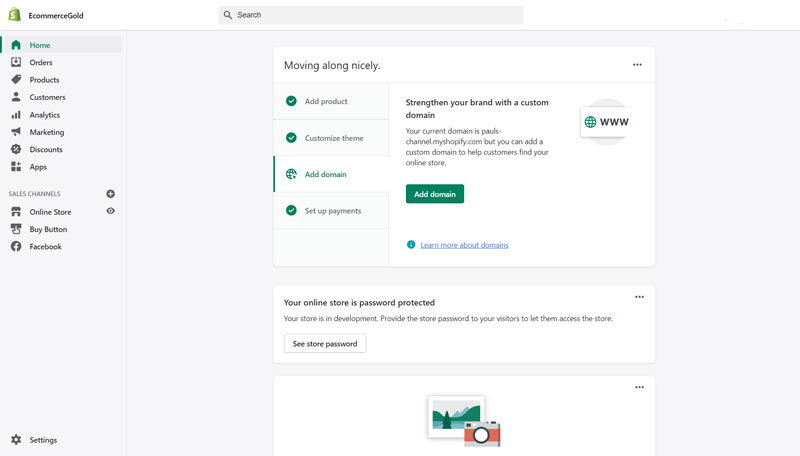
It is worth watching this video series as there is some good information in there, along with some handy tips.
The Shopify dashboard itself is very well designed and has an almost minimalistic feel to it but every section of your site is easy to access from the sidebar navigation menu. And it doesn’t take long to learn where everything is within the dashboard as all of the headings are clearly labeled.
Wix
The process of getting started with Wix is pretty simple as you only need an email address and to create a password in order to get started but you will be asked a series of questions, such as:
- What you are creating the for
- Name of the site
- Purpose of the site (ecommerce, portfolio etc)
- What apps you would like installed
But just be aware that you will need to upgrade to one of their paid plans that includes ecommerce if you want to accept orders on your site.
Once you have completed the sign-up process, you will be taken through to the admin dashboard (which Wix seems to redesign slightly every few months) and will be greeted by quite a comprehensive setup guide.
Which includes steps such as setting up your online store and getting started with marketing your site. The number of steps in the setup guide will depend on which apps you chose to be installed when you went through the setup process.
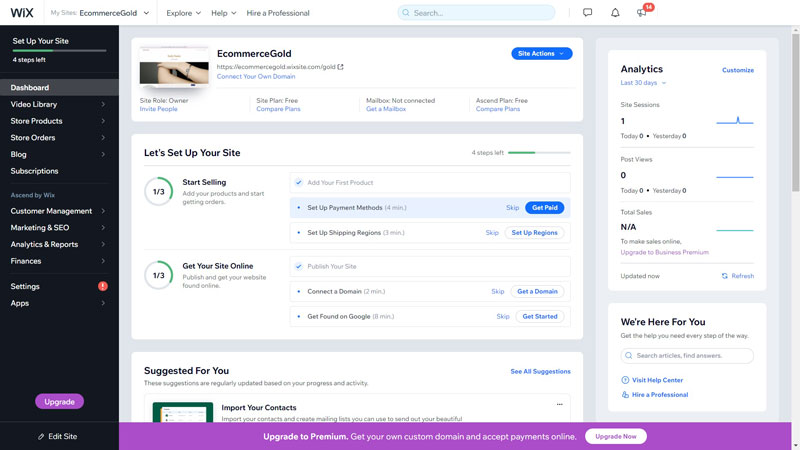
To get the frontend of your site setup (the bit your visitors will see), you will need to go through ADI (Artificial Design Intelligence) setup tool, which asks you to choose a website style for fonts and colors, which template you would like to use and which pages you want to create.
The tool will then spend a few minutes building your website, which can then be customized using the Wix Editor.
The dashboard itself isn’t too bad to use but it is not the most responsive in terms of load time, especially when opening the editor and you may spend a few seconds waiting for pages to load.
Navigating around the dashboard is pretty simple as the main sidebar navigation menu has well-labeled headings but if you install a large number of Wix apps, you might find lots of options added to the navigation menu, which can mean scrolling to find the heading you want.
But there are some aspects to using Wix that are frustrating, such as installing/removing apps as this is all done through the editor and can result in some backwards and forwards between the dashboard and editor.
Adding and Managing Stock
Being able to manage your stock efficiently and effectively is a hugely important part of running an online store and there are three main areas to this, which are:
- Adding products
- Organizing your Products
- Managing your inventory
Shopify
Shopify has gone for a single page layout for their add new product page and as with the Shopify dashboard, it has quite a minimalistic feel but all of the important sections are there and this makes it very easy to add a new product.
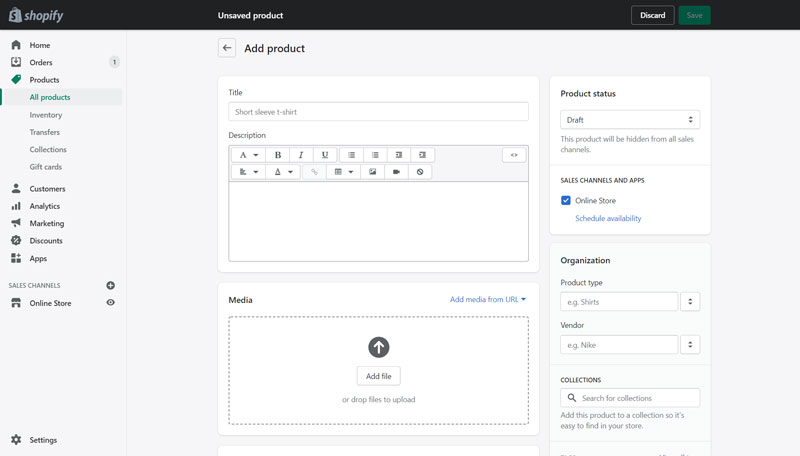
One of the things that is a little different with Shopify, is organizing your products as they have developed their own collection system. In the manual mode, this works in a very similar way to a traditional category system but the automatic mode uses rules based on product tags and to get this working effectively, it is worth reading through the Shopify documentation.
Managing your inventory is very simple as Shopify has two very good bulk editors, the first in the main product overview page allows you to change multiple different elements of the product by using filters to choose what you want to change.
If you just want to quickly update your inventory quantity, then you can use the Inventory section of the dashboard but this offers a similar filter system to the other bulk editor, which allows you to update multiple things at the same time.
Wix
The add new product page in Wix is very similar to Shopify, in terms of being a very simple, single-page layout. What is slightly different, is that you pick whether you want to add a digital or physical product before you are taken to the add new product page.
One thing that is good with the Wix Add Product page is that there are options to promote your product directly from the page, this allows you to start marketing your new products instantly.
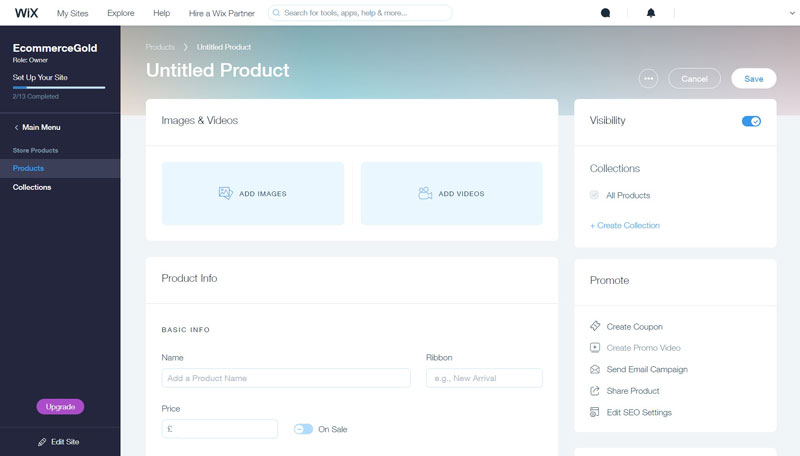
In another similarity to Shopify, Wix also uses collections but they work the same as a traditional category system. Adding a new category is very simple but one of the negatives is that you cannot create sub-collections, this can make organizing a large variety of products quite challenging.
The Wix platform is very limited when it comes to managing inventory as the only bulk editor they have is for inventory quantity, any other edits to the product need to be done by going back in and editing products individually.
Managing Orders
Shopify is somewhat limited in its order management but you can:
- Print basic packing slips
- Export via CSV
- Update or statuses
All in bulk but if you want to print invoices, you will need to install an additional app and although Shopify has a free one, the paid ones by third-party developers offer a lot more functionality.
Wix has a very good order management system as standard, as it allows you to:
- Update fulfillment status
- Export orders
- Print order information
You can also filter orders by fulfillment status, which can make order management a lot easier.
Summary
Shopify Summary
Shopify Pros
• Theme Customization
• 24/7 Support
• Easy to use Admin Area
• The App Store
• Good Performance
Shopify Cons
• Transaction Fees
• Automatic Collection system is a bit complicated
• No option to bulk print invoices
Wix Summary
Wix Pros
• Pricing
• Dashboard set-up guides
• Good Selection of Features
• Add/edit product page
Wix Cons
• Poor Performance
• Slow loading times within the dashboard
• Lack of sub-categories
• Not easy to change theme
Conclusion
Shopify vs Wix – Which one is the Best Ecommerce Platform?
Both Shopify and Wix are viable options for building an online store but Shopify did come out on top in our comparison as we felt that it offered a better overall ecommerce package and some of the areas where it beat Wix were:
- Performance – Shopify outperformed Wix in every one of our performance tests
- Ease of use – Shopify’s dashboard and website builder were easier to use than Wix, especially when it came to changing themes and customization
- App Store – Shopify’s app store is considerably larger and offers a great selection of additional features and integrations.
That’s not to say Wix is bad as it definitely beats Shopify on pricing and offers some features as standard that Shopify doesn’t, such as being able to sell digital products (requires an app on Shopify) but as an ecommerce package, we just don’t think it is as good as Shopify.
But we do recommend trying both platforms out for yourself to find which one works best for your business.

EcommerceGold Score


EcommerceGold Score
Other Comparisons
Hi, I'm Paul, the Owner and Founder of EcommerceGold.
I ran my own Ecommerce Business for over 7 years and now help others start their own online retail empires!

